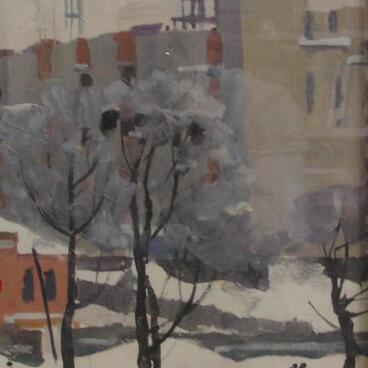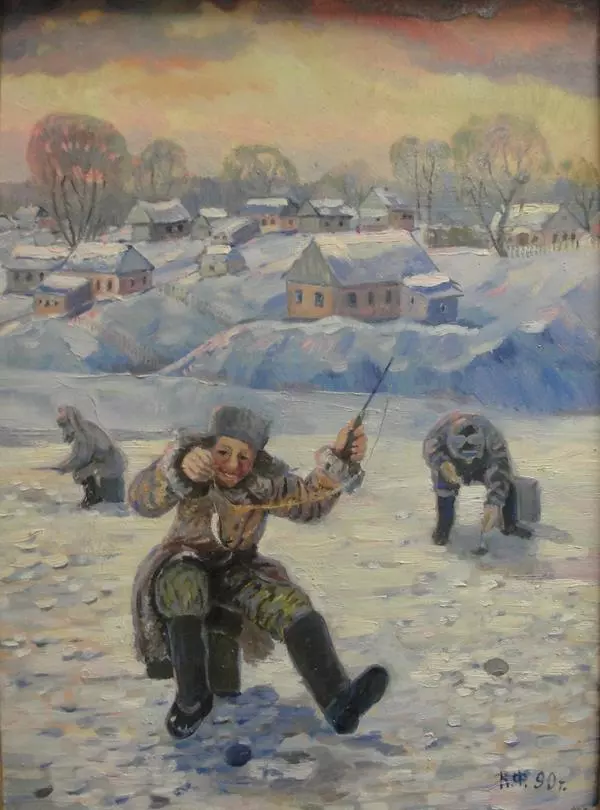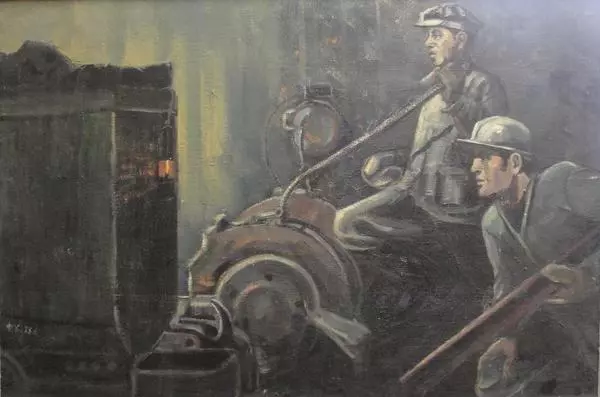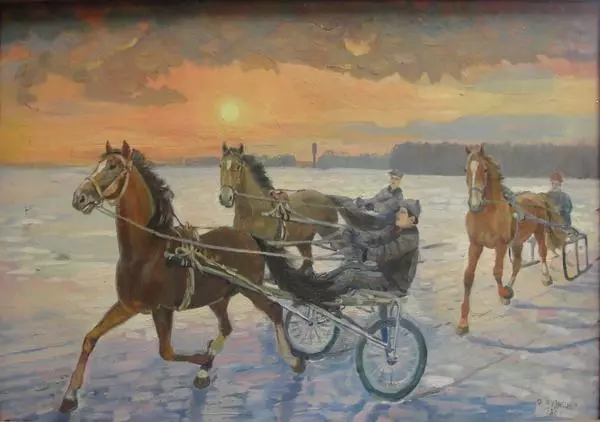Despite a lack of academic artistic education, Fyodor Ustinovich Kuznetsov managed to become a man of gravitas to Russian painter community of the 20th century. He studied fine arts at the All-Union Institute of Arts by correspondence for ten years, from 1955 to 1965. He went to an educational institution quite late, at around age of 30, being a participant and even a prize-winner of a number of exhibitions by that time.
Fyodor Ustinovich dabbled in a diverse range of genres: still life, landscape and portraiture. In 1985, he was awarded a medal of the All-Union Amateur Arts Festival, which took place during the 40th anniversary from the End of the Second World War for his portrait of the WWII veteran Bokovikov. Being able to keenly feel the beauty of nature, Fyodor Ustinovich chose landscape as his main genre. He gifted a number of his paintings to the Uzlovsky Museum of Fine Arts and Local History, including the painter’s self-portrait.
Self-portrait is one of the most complicated genres of painting for several reasons. Firstly, it is indeed complicated to pose for oneself. Secondly, it is hard to describe oneself not only for the painter, but also for any other man, as it needs to be done accurately, without pathos or exaggeration. Fyodor Ustinovich depicted himself on a background of his favorite nature scenery in central Russia. This painting is titled Self-Portrait on Plein Air, and it combines both portrait and landscape genres.
This painting depicts the painter on his search for a picturesque view, getting through a heavy firetop cover. Leaning on a birch stick, he attentively peers into the distance in his daily work clothes, holding his painter’s case. The inquisitive viewer will surely notice that the painter’s staff is held in his left hand. This is no accident: Fyodor Ustinovich is left-handed. One might think that his perfect workplace is yet to be found, and the vista may appear fairly mundane and unremarkable to the viewer. But it is impossible to not be transfixed by the depicted landscape while standing before this painting.
He did this intentionally, to give more room to the wide summer meadow. This says, in no uncertain terms, that the nature of his homeland is always beautiful, no matter the perspective.
There is merit in paying attention to another interesting detail: the top right part of a portrait depicts the albescent crescent, even though the painting depicts daylight. This is not a contrivance, as this unusual natural phenomenon is not uncommon for central Russia. Even though he made himself the main character of the painting, Fyodor Kuznetsov remains true to his artistic creed of landscapist, when the painter’s attentive eyes perceive even the smallest details.
Fyodor Ustinovich dabbled in a diverse range of genres: still life, landscape and portraiture. In 1985, he was awarded a medal of the All-Union Amateur Arts Festival, which took place during the 40th anniversary from the End of the Second World War for his portrait of the WWII veteran Bokovikov. Being able to keenly feel the beauty of nature, Fyodor Ustinovich chose landscape as his main genre. He gifted a number of his paintings to the Uzlovsky Museum of Fine Arts and Local History, including the painter’s self-portrait.
Self-portrait is one of the most complicated genres of painting for several reasons. Firstly, it is indeed complicated to pose for oneself. Secondly, it is hard to describe oneself not only for the painter, but also for any other man, as it needs to be done accurately, without pathos or exaggeration. Fyodor Ustinovich depicted himself on a background of his favorite nature scenery in central Russia. This painting is titled Self-Portrait on Plein Air, and it combines both portrait and landscape genres.
This painting depicts the painter on his search for a picturesque view, getting through a heavy firetop cover. Leaning on a birch stick, he attentively peers into the distance in his daily work clothes, holding his painter’s case. The inquisitive viewer will surely notice that the painter’s staff is held in his left hand. This is no accident: Fyodor Ustinovich is left-handed. One might think that his perfect workplace is yet to be found, and the vista may appear fairly mundane and unremarkable to the viewer. But it is impossible to not be transfixed by the depicted landscape while standing before this painting.
He did this intentionally, to give more room to the wide summer meadow. This says, in no uncertain terms, that the nature of his homeland is always beautiful, no matter the perspective.
There is merit in paying attention to another interesting detail: the top right part of a portrait depicts the albescent crescent, even though the painting depicts daylight. This is not a contrivance, as this unusual natural phenomenon is not uncommon for central Russia. Even though he made himself the main character of the painting, Fyodor Kuznetsov remains true to his artistic creed of landscapist, when the painter’s attentive eyes perceive even the smallest details.






